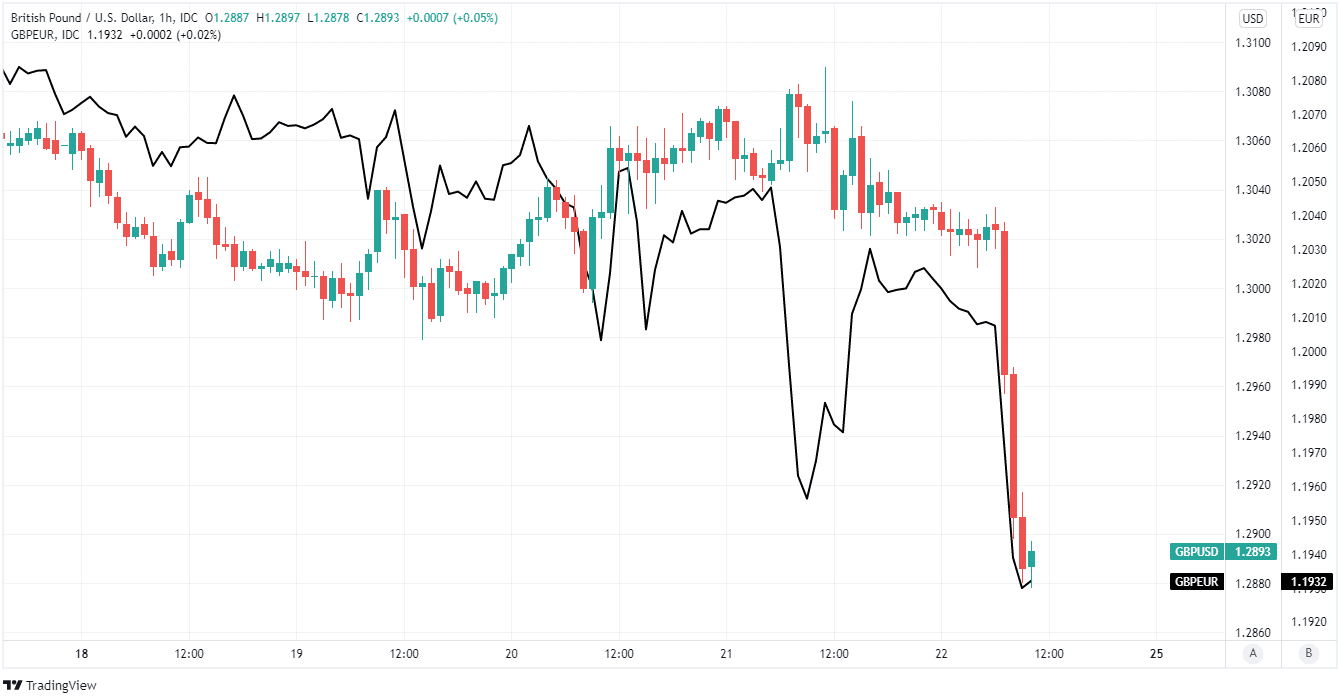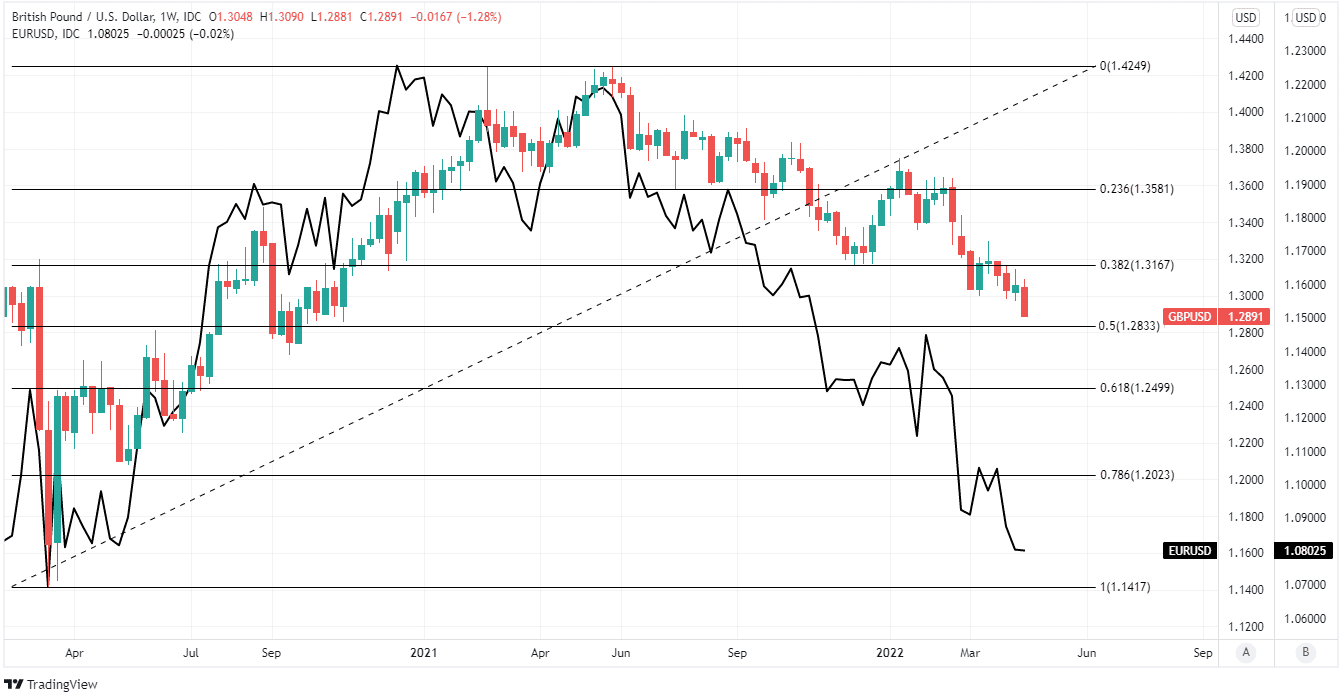GBP/USD Rate Outlook Sours and Brings 1.2837 into View
- Written by: James Skinner
- -GBP/USD tumbles below 1.30 on broad losses for sterling
- -Making beeline toward major chart support around 1.2837
- -Retail sales slump places question mark over BoE outlook
- -As Fed indulges market, placing large rate steps on table

Image © Adobe Stock
The Pound to Dollar rate tumbled from the outset in the final session of the week with a dive below 1.30 bringing a major level of support near 1.2837 on the charts into view after UK economic data forced financial markets to reconsider the outlook for the Bank of England (BoE) Bank Rate.
Pound Sterling was the biggest faller by a long shot on Friday after Office for National Statistics (ONS) data revealed a sharp slump in the volume and value of UK retail sales for last month in a strong indication that squeezed household incomes are now hampering the overall economy.
Retail sales slumped by -1.4%, much more than anticipated by economists and making for their largest one month fall for almost a year in an outcome that came as a hefty blow to a Pound Sterling recently pumped up on overly ambitious market expectations for the BoE’s interest rate.
"The hefty fall in retail sales in March marks the second consecutive month of decline and adds to signs that the real wage squeeze is hitting consumer spending," says Bethany Beckett, an economist at Capital Economics.
“With CPI inflation already at a 30-year high and set to keep rising, there’s a real risk of outright falls in consumer spending in the coming quarters,” Beckett also said in a review of the data.
 Above: Pound to Dollar rate shown at hourly intervals alongside GBP/EUR.
Above: Pound to Dollar rate shown at hourly intervals alongside GBP/EUR.
GBP to USD Transfer Savings Calculator
How much are you sending from pounds to dollars?
Your potential USD savings on this GBP transfer:
$318
By using specialist providers vs high street banks
"The position of the GBP-USD 2Y swap rate differential relative to cable suggests the decline in spot is slightly overdone (near-term), but we think the direction in the GBP on the basis of fundamentals is the correct one," says Stephen Gallo, European head of FX strategy at BMO Capital Markets.
"We favor the short side of GBPUSD, particularly on rallies above 1.30," he also said on Friday.
Pound Sterling had rallied in the prior session after financial markets inferred, perhaps erroneously, that BoE policymaker Catherine Mann was suggesting in a Thursday speech that she could vote for a large 0.5% increase that would take Bank Rate up from 0.75% to 1.25% in May.
Monetary Policy Committee (MPC) member Mann cited “very strong sales and price forecasts” from large companies participating in the BoE’s surveys and the prospect of labour force pay rises for anticipating ongoing risks of a protracted period of above-target inflation on Thursday.
"GBP/USD 1.30 now seems to have broken decisively and 1.25 is a realistic target. GBP/USD will likely match any EUR/USD fall that comes as a result of concerns about gas supplies to Europe and the state of the war in Ukraine," warns Kit Juckes, chief FX strategist at Societe Generale.
Above: Market expectations for BoE’s Bank Rate. Source: Westpac.
GBP to USD Transfer Savings Calculator
How much are you sending from pounds to dollars?
Your potential USD savings on this GBP transfer:
$318
By using specialist providers vs high street banks
“Monetary policy needs to keep inflation expectations anchored; by doing so now, less tightening will be required later, when demand may still be weak,” she said in a BoE webinar.
Mann suggested that if these sales and price forecasts actually materialised and “should the impact on aggregate demand of the energy price shock end-up being more modest than currently foreseen,” then the BoE would likely have to raise interest rates sharply in the months ahead.
March retail spending data may have all but ruled out that idea, however.
We just concluded our #MacroWeek2022 discussion with Bank of England Governor Andrew Bailey. He & @AdamPosen covered UK inflation & targeting regimes, financial sanctions & stability, crypto, & forays into central bank digital currencies.
— Peterson Institute (@PIIE) April 21, 2022
Watch it here: https://t.co/xGc1xfdgd8 pic.twitter.com/Ao6vkCELu6
Friday’s IHS Market survey of large services oriented companies also pointed toward growing headwinds in what is the UK’s largest economic sector.
“This really repeats what we said in the February monetary policy report and the March MPC minutes, you know, we are now walking a very fine line between tackling inflation and the output effects of the real income shock and the risk that that could create a recession,” Governor Andrew Bailey told the Peterson Institute for International Economics while in Washington on Thursday.
The Pound to Dollar exchange rate reached its lowest level since September 2020 in the wake of Friday’s data and was fast closing in on a major level of technical support on the charts.
 Above: Pound to Dollar rate at weekly intervals with Fibonacci retracements of 2020 recovery indicating possible medium-term areas of technical support for Sterling and shown alongside EUR/USD. Click image for closer inspection. Click image for closer inspection.
Above: Pound to Dollar rate at weekly intervals with Fibonacci retracements of 2020 recovery indicating possible medium-term areas of technical support for Sterling and shown alongside EUR/USD. Click image for closer inspection. Click image for closer inspection.
GBP to USD Transfer Savings Calculator
How much are you sending from pounds to dollars?
Your potential USD savings on this GBP transfer:
$318
By using specialist providers vs high street banks
"We estimate consumer confidence suggests around a 35% probability of recession. Surveys of firms are stronger, however," says Robert Wood, a UK economist at BofA Global Research.
Pound Sterling’s losses were buttressed by a strong Dollar after Federal Reserve (Fed) Chairman Jerome Powell told the latest International Monetary Fund and World Bank Group meeting on Thursday that a larger-than-usual interest rate rise is now on the table in the U.S. for next month.
While financial markets were already pricing-in a 0.50% uplift in the Fed Funds interest rate, from 0.5% to 1%, the Dollar still advanced broadly overnight and in the final session of the week.
“Mike Tyson once opined, “Everyone has a plan until they get punched in the face.” On Wednesday, markets tried to plan for “peak inflation”; on Thursday, they were punched in the face,” says Michael Every, a strategist at Rabobank.
“In Fed-speak: Daly said rates could rise in 25bp, 50bp, or 75bp steps, so jabs, upper-cuts, and ear-biting, respectively; Bullard warned, “The bond market is not looking like a safe place to be”; and Powell backed a one-two of 50bp hikes, which is now priced in. His goal is also “to get inflation down without a recession,” Every wrote in a Friday market commentary.





